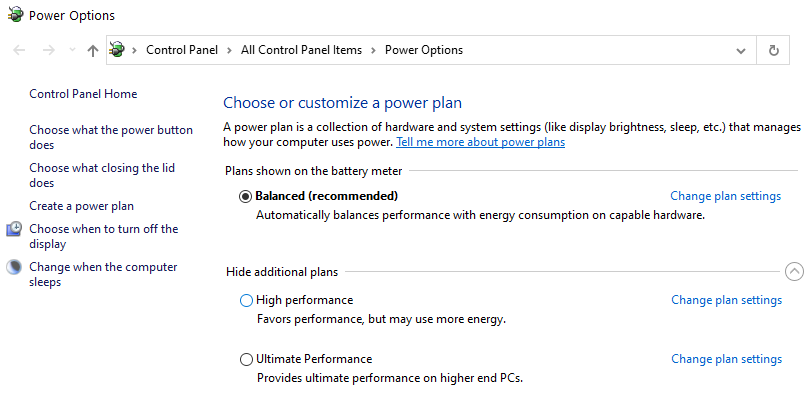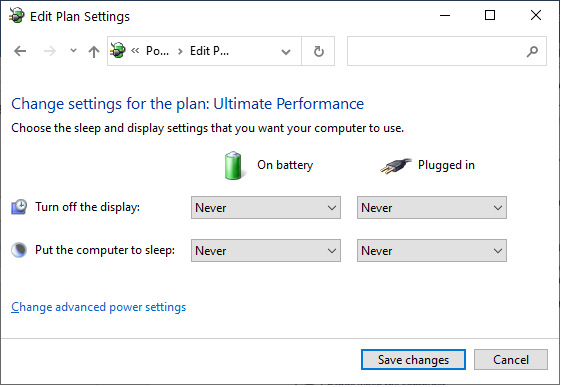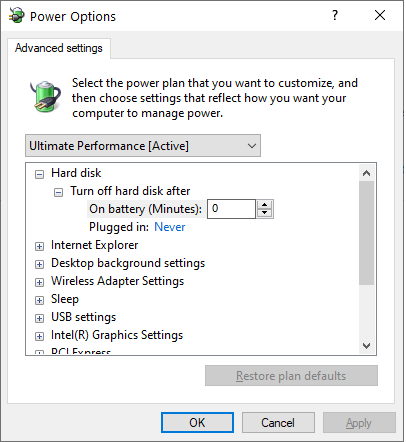Open your Powershell, press Winkey + X to open the Quick Access Menu, and select Windows PowerShell (Admin) or Windows Terminal (Admin) on Windows 11 :

Copy the following commands (one at a time, just the text in italics) to your clipboard, paste them into the PowerShell Window and press Enter to install each new plan.
High Performance:
powercfg -duplicatescheme 8c5e7fda-e8bf-4a96-9a85-a6e23a8c635c
Ultimate Performance:
powercfg -duplicatescheme e9a42b02-d5df-448d-aa00-03f14749eb61
Open your Power Options again and you will see that two additional power plans are now available:

We will use the Ultimate Performance power plan and optimize it further for our audio-processing scenario; select it and click on Change plan settings:

If not already selected by default, choose Never for every combo box, and then click on Change advanced power settings:

Many options are correctly configured by default for this power plan, e.g. see the Hard disk section above. You definitely do not want Windows to turn off your hard drives, whether you are running on battery or plugged in. We do however recommend that you always plug in your laptop for your live performance.
Set the other options accordingly (use the same parameters for both On battery and Plugged in modes):
•Internet Explorer -> JavaScript Timer Frequency: Maximum Power Savings; although this setting affects IE users only, we do not want to pay much attention to JavaScript execution here.
•Desktop background settings -> Slide show: Paused; although a background slideshow on your desktop is quite an appealing feature, turn it off, as you do not want to spend even a bit of CPU power for this during your gig.
•Wireless Adapter Settings -> Power Saving Mode: your choice. If you did not disable your wireless adapter (in the previous chapter) you are probably using it to send OSC/MIDI messages to your audio plugin host or a DAW, so set it to Maximum Performance.
•Sleep settings are correctly configured for the Ultimate Performance power plan. You do not want your PC to go into Sleep, Hybrid sleep or Hibernation mode during your performance.
•USB settings -> USB selective suspend setting: Disabled; every PC used for live performance is going to be using some USB devices, such as a USB audio interface, USB MIDI keyboards or possibly even a USB mouse. You do not want these USB devices to be suspended while you are gigging.
•Intel(R) Graphics settings: leave as is (Maximum Performance).
•PCI Express -> Link State Power Management: Off; this means we do not want any power savings, and the PCI Express will stay active regardless of the state of the PC or laptop.
•Processor Power Management -> set both Minimum and Maximum processor state to 100%; this means we do not want to use any CPU power saving mechanisms, so the CPU is always ready for processing at full capacity. Additionally, set System Cooling Policy to Active (if this setting is available). This means that the operating system will not reduce your CPU power to cool it down, but instead will increase the speed of your fans.
•Display: leave as is (Never).
•Multimedia Settings: leave the default configuration of these settings for this power plan.
•Battery: leave the default configuration of these settings for this power plan.
After you configure these settings, click on the OK button to save your changes.